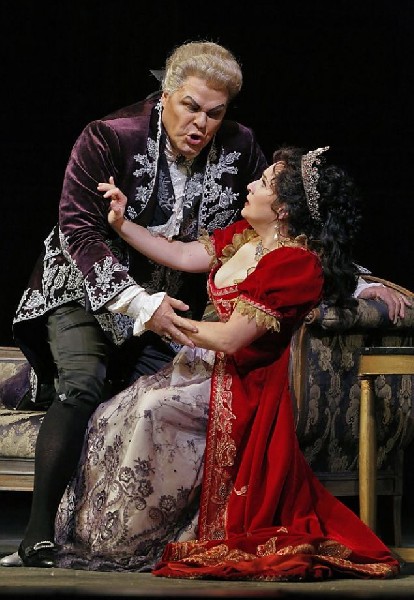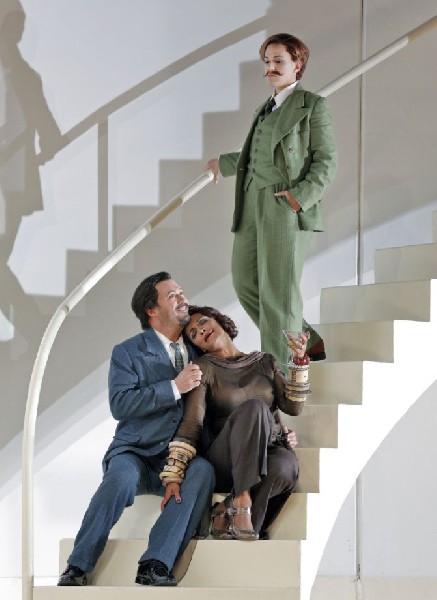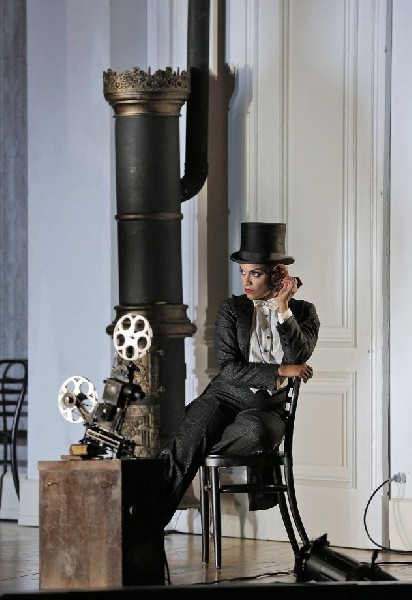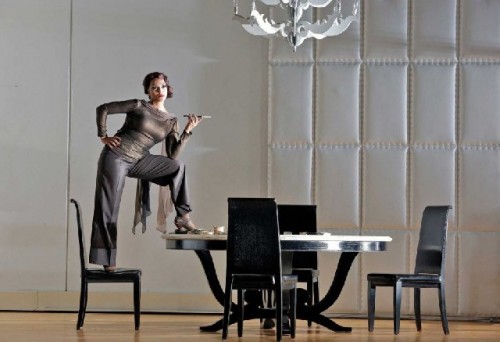Revisiting San Francisco Opera
Tosca and Partenope Evoke Vivid Memories
By: David Bonetti - Nov 01, 2014
Tosca and Partenope
San Francisco Opera
October 23 and 24, 2014
“Tosca”
Music by Giacomo Puccini
Libretto by Luigi Illica and Giuseppe Giacosa
Based on the play “La Tosca” by Victorien Sardou
Premiere: Rome, 1900
First San Francisco Opera performance: 1923
Remaining performances: Nov. 4 & 8
Conductor: Riccardo Frizza
Director: Jose Maria Dondemi
Production designer: Thierry Bosquet
Lighting designer: Gary Marder
Cast: Lianna Haroutounian (Floria Tosca), Brian Jagde (Mario Cavaradossi), Mark Delavan (Baron Scarpia), Scott Conner (Cesare Angelotti), Dale Travis (Sacristan), Joel Sorensen (Spoletta), Efraín Solis (Sciarrone), Pietro Juvara (Shepherd boy), Hadleigh Adams (Jailer)
“Partenope”
Music by George Frideric Handel
Libretto based on Silvio Stampiglia
Premiere: London, 1730
First San Francisco Opera performance
A co-production of the English National Opera and Opera Australia
Conductor: Julian Wachner
Director: Christopher Alden
Set designer: Andrew Lieberman
Costume designer: Jon Morrell
Lighting designer: Adam Silverman
Cast: Danielle de Niese (Partenope), David Daniels (Arsace), Daniela Mack (Rosmira), Alek Shrader (Emilio), Philippe Sly (Ormonte), Anthony Roth Costanzo (Armindo)
I hadn’t attended a San Francisco Opera performance in 14 years, when I moved from the City by the Bay to St. Louis, where the two mightiest rivers in North America, the Mississippi and the Missouri, meet. In recent years, I’d been in the Opera House, but during ballet season. The San Francisco Ballet is an estimable company, the oldest in America and one of its finest. But the massive Beaux-Arts auditorium – nearly 3,200 seats - where they both perform is called the Opera House for good reason. Despite the Giants, opera is the name of the game in San Francisco, and it has been since the company first performed in 1923 and especially since it moved into its splendid new digs in 1932.
How pleasant it was to attend the opera in San Francisco, especially on a balmy night, which you can’t always count on in that foggy town. As I walked down Van Ness Avenue, I joined the crowd heading to the opera. It was opening night for “Tosca” and a hot young Armenian soprano was making her local debut. People lingered on the steps leading to the entrance. Above, in the loggia, early arrivals leaned out watching the mob approach, flutes of champagne in their hands. All the buildings in Civic Center were bathed in orange light in honor of the local baseball franchise. (Let me report: orange does not become Beaux-Arts architecture.) Going to the opera is the most sophisticated way you can spend an evening in San Francisco.
The second largest opera company in America after the Met in terms of budget, numbers of productions and attendance, the San Francisco Opera is a remarkable achievement for a city only a little larger and richer than Boston. But having to fill its big barn of a house night after night from September to July (with a winter break for the ballet) is a challenge. This year there are ten productions, ranging in time from Handel to Carlisle Floyd with a world-premiere by Italian composer Marco Tutini, “La Ciocara,” based on Vittorio de Sica’s movie “Two Women,” which starred Sophia Loren in her greatest dramatic role.
During the years I went to the opera regularly, I experienced many memorable performances and productions – Renee Fleming as the Marschallin; Kiri te Kanawa as the Countess, wearing gowns by Gianni Versace, in Strauss’s “Capriccio”; Cecilia Gasdia as Desdemona in Rossini’s “Otello”; David Daniels and Lorraine Hunt Lieberson in a stylish production of Monteverdi’s “L’incoronazione di Poppea”; Samuel Ramey in Boito’s “Mefistofele”; and Tom Fox and Ashley Putnam in Hans Werner Henze’s “The Sailor Who Fell from the Sea” stand out. An entire generation of young Russians was brought to San Francisco in the early ‘90s by company director Lotfi Mansouri – the man who invented supertitles – when he realized that the Soviet Union was collapsing and there was a trove of well-trained singers yearning to sing in the West, some of whom might be good. That they included Anna Netrebko, Olga Borodina and Dmitri Hvorostovsky was our good fortune.
But for every triumph there seemed to be three or four duds. One season the only good production (in my estimation) was Benjamin Britten’s “Peter Grimes,” maybe the grimmest opera in the repertory. Probably the worst performance I’ve ever heard in a major opera house was discount diva Carol Van Ness’s hubristic attempt to sing Bellini’s Norma. I wish I had brought with me a basket of over-ripe tomatoes.
But let’s not dwell on the disappointments. The company’s efforts to represent the full opera repertory are valiant, especially when you contrast its schedule with the Met’s, which seems to be wedded permanently to the 19th century despite company director Peter Gelb’s inept attempts to pull the company into the 21st century. At the SFO I heard local-son John Adams’s “The Death of Klinghoffer” in the early ‘90s in the original Peter Sellars’s production, and I don’t remember any protest. Maybe San Franciscans are just more sophisticated than New Yorkers.
And let’s not even talk about opera before Mozart. The Met was very late in embracing Baroque opera, which has entered the repertoires of most of the major companies in the western world. Yes, it has done Handel’s “Guilio Cesare in Egitto” and it empowered William Christie to create a Baroque pastiche for Placido Domingo, but it hasn’t gone much beyond that. True, houses as large as the Met and the SFO are not the best places to see operas written in the 18th century for theaters that might have seated a few hundred. But in the early ‘90s, I saw SFO’s production of Vivaldi’s “Orlando” starring Marilyn Horne, and during my San Francisco years, I also heard Handel’s “Giulio Cesare,” “Alcina” and “Semele,” and Monteverdi’s “L’Incoronazione di Poppea” in hip, stylish productions.
The two operas I heard on my most recent visit nicely exhibit the company’s range and ambition.
“Tosca” is one of opera’s surefire hits, done by companies everywhere even if they don’t have sopranos who can sing the title role, as both the Boston Lyric Opera and the Opera Theater of St. Louis demonstrated in recent years. It was first produced by the SFO in 1923, and it opened the new house in 1932 with Claudia Muzio in the title role. In 1997, when the house reopened after being retrofitted and refurbished after the 1989 earthquake, Mansouri decided to recreate the original production by Armando Agnini, who served as the opera’s primary director for 30 years. Veteran Belgian designer Thierry Bosquet adapted the historical artifact.
The production is as fusty and dated as you might expect. SFO regulars I know complained that they had to see it again – after its 1997 premiere, it was reprised in 2001, 2004, 2009 and 2012 – but I found it to be fascinating. (I had skipped the 1997 premiere because Carol Van Ness, the soprano I loved to hate, starred.) The Boston Early Music Festival and other early music groups go to great trouble to create historically authentic productions of 17th and 18th century works. Hardly anyone bothers to do the same with later operas. Instead we get hack jobs because people will come no matter what to hear “Vissi d’arte” or post-modern, so-called “Euro-trash” productions that as often do violence to the originators’ dramatic intentions as shed new light.
The sets and costumes for the SFO’s “Tosca” were naturalistic. The church of Sant'Andrea della Valle in Act I, Scarpia’s salon in the Palazzo Farnese in Act II and the Castel Sant’Angelo in Act III - all iconic Roman sites – looked as they would look to contemporary visitors. (But why Bosquet added a pair of domes to St. Peter’s in Act III I don’t understand. Wasn’t what Michelangelo’s creation good enough?) And the costumes were appropriate to the period – high-waisted gowns for Tosca and tight, sexy trousers and short jackets for the men. Think Napoleon and Josephine and their court.
Of course, most of the audience didn’t give a hoot about the period detail, although they applauded the scenery in Act I. They came to hear the singing.
As Tosca, the reigning soprano in Rome with a temperament that comes with the role, Lianna Haroutounian was an appealing performer in what was a role debut for her. (Elsewhere, in major houses such as Covent Garden and the Teatro San Carlo in Naples, she has sung Elisabetta in “Don Carlo,” Leonora in “Il Trovatore,” Amelia in “Un Ballo in Maschera” and Desdemona in “Otello.) It must have been daunting for her to sing one of the central roles of the dramatic soprano repertory for the first time in a theater with at least a thousand seats more than what she is used to. Although her singing was always correct, I found her voice weak at times, fading into the scenery. There was no ravishment where there should have been. Worse, she didn’t seem to totally inhabit the role dramatically – that might come with time. In the first act, she showed no real outrage at what she thinks to be her lover Cavaradossi’s secret admirer, “La Attavanti,” one of the great outbursts in the opera literature.
In Act II, she essayed the great “Vissi d’arte” effectively, turning it into a true internal dramatic monologue. But she showed no real passion. The exchange, “Quanto?” “Il prezzo” (How much? The price?), to Scarpia, the Roman police chief, was emotionally flat, as was the final scene of the act when she stands over Scarpia’s dead body and speaks the words, “Avanti a lui tremava tutto Roma” (Before you, all Rome trembled), a line most sopranos milk for everything it is worth. All in all, Haroutounian’s Tosca is a work in progress. Someday, I might look back and brag that I heard her premiere in the role.
Her hot-blooded lover Cavaradossi, a partisan for the short-lived Napoleonic Roman Republic, was sung by the handsome young American tenor Brian Jagde. He sang his two big arias, Act I’s “Recondita armonia” and Act III’s “E lucevan le stelle” – one of the most beautiful arias in the tenor repertory - with sweet lyricism.
Veteran baritone Mark Delavan – he’s sung in 17 previous SFO productions – was a cool Scarpia. His entrance toward the end of Act I while the Te Deum is being played and the entire hierarchy of the Roman church has just entered in a show-stopping procession should be chilling, but he seemed to be just an old man with his henchmen in the crowd. In the second act, he proved to be appropriately suave in his attempt to seduce Tosca. Whatever his dramatic limitations, he was always vocally persuasive.
The most assured performance was that of SFO stalwart, bass-baritone Dale Travis, as the stupid, reactionary Sacristan. The only comic figure in the opera, he was a welcome relief to the deliriously overwrought melodrama.
Italian conductor Riccardo Frizza led the orchestra with idiomatic sensitivity. But all in all, it was a “Tosca” without passion, and a “Tosca” without passion is not really a “Tosca” at all.
The next night Handel’s “Partenope” was a visitor from another planet. Terminally hip, the production exuded style and attitude. The opera was originally set in Naples in distant times during the reign of Queen Partenope, who is pursued by seemingly every noble male in the neighborhood. Director Christopher Alden, who is known for taking liberties with pre-existing texts, set it instead in 1920s Paris, the time of the Dada and surrealist artists. That sounds potentially like a good idea – the story’s absurdities could be played as Dada pranks. One of the characters, Emilio, the King of the neighboring kingdom who has declared war because Partenope has rejected his professions of love, has been turned into Man Ray, wandering around taking pictures as if he were a photojournalist like Weegee. But the production turns out to be more slapstick than Dada, and there is a difference. (Alden, by the way, was responsible for the productions of both the Henze and Monteverdi operas I previously cited as among the most memorable I’d heard at the SFO.)
Handel wrote more than 40 operas, some of them as great as any in the 350-year history of the genre. But many of them don’t reach the heights of “Giulio Cesare in Egitto,” “Rinaldo,” “Orlando” or – well, the list is long. “Partenope,” which was receiving its first production at the SFO, is one of his lesser efforts. It possesses a convoluted plot about lovers at cross-purposes, and without cuts goes on for more than four hours. Even with SFO’s cuts, it lasted three and a half hours (with two intermissions). If you ask me, there could have been more cuts - a lot more cuts. With such a silly story to tell, who needs to hear every iteration of every character’s emotional journey? Of course, that would mean cutting some of Handel’s glorious music, which he poured into even some of his four-hour long toss-offs, so you can understand why opera companies are reluctant to cut.
The opera has its comic elements, and Alden wisely chose to turn the work into a full-fledged comedy, including a scene in which toilet humor inexplicitly played a major part. Throughout the evening, the characters, as if they were regulars at the Algonquin round-table, consumed cocktail after cocktail. If it wasn’t exactly what Handel had in mind - if we could read his mind 250 years after his death - it made the audience happy. The three women sitting next to me laughed through the entire opera, and at intermission one told me that it was her third time hearing it. I bet that’s exactly what the SFO management was hoping for.
The evening was a lot of fun although it ended up being one of those cases when the party goes on way too long. In the first act set designer Andrew Lieberman had a lot to do with its success, creating a sleek, stark white Art Deco salon with a curving staircase out of a Fred Astaire movie. (The sets in the second and third acts were more confused and less effective.) Costume designer Jon Morrell gave each of the characters a monochromatic suit that stood out nicely against the blindingly white background.
The SFO supplied the production with a stellar cast adept at singing the elaborate ornamentations of Baroque music and in a couple of cases capable of extreme physical comedy.
The headliners were soprano Danielle de Niese as Partenope and countertenor David Daniels as her leading suitor Arsace, in the original, the King of Corinth. De Niese, one of the rising stars of early music in the big opera houses, was sexy - her form-fitting costume revealed all her considerable assets - and game. After all, she was a prime cock-tease, keeping five men, one of them a woman in drag, in her thrall. Vocally, although capable of a lovely lyricism and an effortless coloratura, she often forced her high notes and ornamentations, especially in the first act.
Daniels has been opera’s major heroic counter-tenor for so long we tend to forget that the high-tenor vocal register was not that long ago considered freakish and unnatural. Daniels is a master of Baroque style and there is nothing unnatural about his sweet voice at all. Although his singing isn’t as exciting as it was a decade ago, and at the end of the second act it was hooty and labored, he is still a formidable presence on stage. As the classic lover who can’t make up his mind between two attractive women, both of whom he loves and who profess to love him, he was one of the few “serious” characters in the opera and we felt for his dilemma. But why was he revealed in the bathroom seated on the toilet wrapped in toilet paper like a mummy? Was Alden trying to show that he was emotionally constipated or was it just to elicit laughs? (Which it did.)
As Rosmira, disguised as Prince Eurimene in order to spy on and win back her betrothed, the fickle Arsace, mezzo-soprano Daniela Mack possessed a lovely voice, flexible with easy high notes, but she failed to make much of an impression in such high-spirited company.
The high-jinks were provided by both Alek Shrader as Emilio, passing as Man Ray, and Anthony Roth Costanzo as Armindo, in love with Partenope but too wimpy to fully make his case. (That he ends up with her says something about passive-aggression as a seduction technique.)
Both Shrader and Costanzo were masters of physical comedy. At one point Shrader, young and handsome, whose tenor was sweet and expressive, effortlessly bounced off the walls like a member of Pilobolus or Cirque de Soleil.
The diminutive Costanzo stole the show. Possessing a fresh, sweet, flexible countertenor, he demonstrated his talents as a circus performer as well. In the first act, while tossing off perfect Baroque ornamentations, he fell up stairs and then down, having had too much to drink, topping it off by singing while hanging off the curving staircase, swinging his legs in space. A bravura performance, which he topped off (a second time) in the final act by suddenly and expertly tap dancing across the stage, making the Fred Astaire references of the first act literal. Oh, yeah, he also sang an aria shirtless.
In the original, Ormonte, Partenope’s advisor, is not much of a role. But Alden turned him into Partenope’s “gay confidante,” giving him a couple of swishy moments, suggesting that he was into rubber and outfitting him in a preposterous outfit to go into battle. Bass-baritone Philippe Sly played him with good humor – what else could he do?
Conductor Julian Wachner kept the endless evening going with propulsive beats.
At a time when performing arts organizations are going under, their plutocratic boards demanding that their workers – the musicians in the pit and backstage magicians who make it all happen - take often huge pay cuts so the show can go on, the SFO’s ambition to represent the full extent of the opera repertory in a variety of productions is something of a miracle and something to celebrate.






